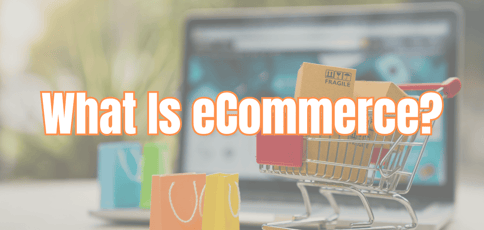
In the simplest terms, eCommerce is the buying and selling of products and services over the internet. This electronic version of traditional commerce (hence the name) takes place between various parties, such as businesses and consumers (B2C), businesses and other businesses (B2B), or consumers and other consumers (C2C).
Because almost every type of goods and service is available through an online transaction, eCommerce has forever reshaped how we shop for things and how companies operate. As such, it represents a critical part of the modern business landscape — so much so that it would be hard to imagine our world without it.
-
Navigate This Article:
The Evolution of eCommerce
With its omnipresence, it’s difficult to fathom that eCommerce has an origin story predating dial-up internet access and the cacophony of sounds that accompanied it.
The story of exponential growth is most evident through numbers. Today, the eCommerce market is massive, projected to hit the $6.33 trillion mark this year, up from an estimated $5.784 trillion in 2023.
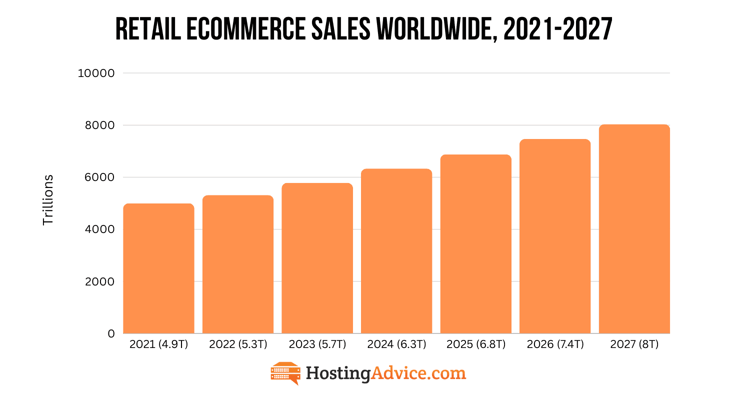
What’s more, the upward trajectory will continue over the next few years, further showcasing the ever-lucrative nature of online shopping.
Early History: Origins and Development
It might surprise you to read that eCommerce started well before the internet as we know it. Most people attribute its emergence to an English inventor and entrepreneur, Michael Aldrich. In 1979, he created Videotex, a teleshopping system based on a phone line connection between a TV and a computer.
Some of you may recognize ‘teleshopping’ as the TV selling technique where a person urges viewers to make a phone call and buy goods. This was not the case at the time. Here, the connected computer processed transactions in real time, thus becoming the precursor of online shopping.
September of the same year saw the first public demonstration of online shopping, while March 1980 saw the definitive launch of what was later designated online shopping, eCommerce, and eBusiness.
The Rise of eCommerce Platforms
A decade and a half after Aldrich laid the foundation, the first genuinely online transaction occurred. In August 1994, Dan Kohn created a website called NetMarket and sold a CD to a friend. Some reports point to The Internet Shopping Network beating Kohn to the punch, selling computer equipment roughly a month before.
Whether the honor of a first eCommerce sale goes to a CD or a floppy disk (our best guess), the fact remains that 1994 was the defining year for eCommerce. Netscape Navigator, the leading browser of the era, launched that year, further increasing the WWW revolution and, almost by proxy, online shopping.
From there on, things snowballed. Driven by expanding access to the web and increased safety, eCommerce marketplaces started sprouting left and right. Brick-and-mortar retailers followed suit and embraced the “new way” to stay competitive against newcomers like Amazon, eBay, Alibaba, and others.
For the expansion to happen at scale, a lot of pieces had to fall in together. None were more important than early online payment systems that made it possible to safely use credit cards for purchasing. They were arguably the pillars of eCommerce infrastructure as they not only allowed for secure transactions but also performed their role in a user-friendly manner — a prime example being PayPal.
This was the time when broadband became more available, allowing for faster and smoother shopping experiences. Simultaneously, advancements in logistics and fulfillment translated to better shipping options and shorter delivery times.
The late 2000s ushered in the inception of mobile technology, adding more options for consumers to shop on the go. With a few taps, they could easily buy online from wherever and whenever, by which time online marketplaces like Shopify, Etsy, Groupon, and alike were slowly becoming household names.

Major Milestones in eCommerce History
It’s fair to say that eCommerce has had a fairly straightforward narrative, resulting in a business model that has remained, in its essence, largely unchanged (but rather refined) since the mid-90s. However, some developments defined the shape and future of the industry, starting with the introduction of secure online payments.
Back in the early days, you had to download a specific program to safely transmit your credit card data. The interface wasn’t intuitive and required a certain degree of tech know-how, so most people didn’t trust it. It didn’t help that there were no standards for incorporating encryption into web browsers.
Still, all of that changed when Netscape released a version of its browser that incorporated the Secure Sockets Layer (SSL) security protocol. Microsoft duplicated the move for its Internet Explorer browser, opening the gates for the safe passage of confidential information on the web.
Subsequently, numerous companies started incorporating payment gateways to facilitate online transactions, while the number of payment service providers and processors exploded in an effort to get a piece of the action.
Such competitive surroundings meant oversight was badly needed. So, the Payment Card Industry Security Standards Council (PCI) was formed in 2004 to ensure everyone was playing by the book, a.k.a complying with various security requirements.
Toward the end of the decade, eCommerce platforms like Alibaba and Flipkart led the charge when it came to localized payment solutions. As two of the more prominent platforms, Alipay in China and Paytm in India were responsible for increasing the volume of online payments.
At the same time, the advent of smartphones spurred the growth of mobile payment apps and digital wallets, most notable being Square and Google Wallet. Their launch was another pivotal technological advancement as they quickly set the global standards for digital payments.
Types of Online Business Models
With so many ways to buy and sell, it’s no surprise that eCommerce takes on different forms. Here are the most common business models:
Business-to-Consumer (B2C)
The traditional and most widespread model, B2C refers to a direct exchange of products, services, and/or information between a business and an individual consumer. Virtually everything is up for grabs, so to speak: tangible products like clothing and electronics, digital goods such as games and music, services of all kinds (hospitality, HVAC repair, online tutoring, etc.), educational courses, and so on.
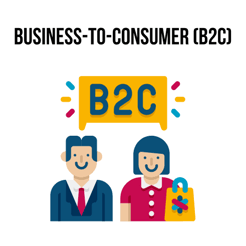
With a simple transaction at its core, the business-to-consumer model is characterized by its universal reach and the fact that consumer behavior is the primary driver. Any merchant can sell across the globe, often regardless of their offering, as long as there is someone interested in buying.
Incidentally, those are also its two biggest challenges. Consumers are dynamic, so companies planning to leverage B2C must have a deep understanding of customer needs and desires and provide goods (along with excellent customer experience) that align with these preferences. Since the competition is tough, a strong differentiation is needed to establish and maintain the market position.
Business-to-Business (B2B)
In this case, a business sells to another business, where the buyer is either the end user or resells to the consumer.
The former entails SaaS companies that sell some form of software to other companies (e.g., Salesforce) or businesses that offer digital services (e.g., marketing management, accounting, procurement). On the other hand, the latter involves wholesale eCommerce companies selling their products in bulk at a discount to other businesses.
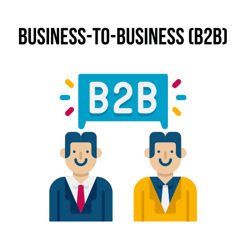
Certain challenges accompany the B2B model, starting with a longer sales cycle than B2C. Communicating with multiple decision-makers, such as execs and managers, across numerous touchpoints is common, meaning it takes time to build customer relationships. This implies higher customer acquisition costs, so B2B companies need to plan carefully and sustain themselves over an extended period before a sale is made.
However, the rewards are more bountiful, as B2B transactions often entail larger quantities and higher values. Since the market is more stable and predictable due to its gradual growth, it’s easier to adapt and strengthen the online presence and business relationships, which equals getting more potential clients and recurring purchases.
Consumer-to-Consumer (C2C)
A business model where consumers sell to other consumers, C2C typically refers to online marketplaces that connect consumers. These are your eBays, Etsys, Airbnbs, and Ubers of the world that facilitate the underlying peer-to-peer paradigm by enabling the selling or sharing of oft-underutilized goods and service capacity.
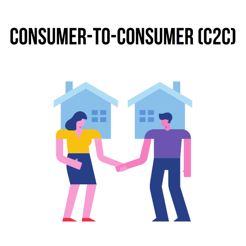
Because there is no intermediary, the entire process of supply and demand moves fluidly, with the marketplaces making their money by charging various fees.
In this sharing economy, every stakeholder benefits in some way. Consumers enjoy lower expenses and more convenience as they get to use a specific product/service instead of settling for a one-size-fits-all variant. Since there are no middlemen or usual trade expenses (renting a store, staff wages), the cost of the product/service being offered is lower for providers, increasing their profitability.
Impact of eCommerce on Business and Society
Being the revolutionary force it is, eCommerce has affected numerous layers of our daily lives, creating new opportunities and efficiencies. The statistics paint a clear picture of just how big our dependence on eCommerce is and the scope of its role.
Economic Implications
In one fell swoop (more or less), eCommerce has erased geographical borders, allowing businesses of all shapes and sizes to reach beyond their local areas and expand to every corner of the Earth. Powered by interconnectedness, every merchant today can have a global customer base and tussle with larger companies. This has led to increased competition and more possibilities for innovation and growth.
- Retail eCommerce sales are estimated to exceed $6.3 trillion worldwide in 2024, and this figure is expected to reach new heights in the coming years.
- 52% of online shoppers report shopping internationally.
- There are more than 26.5 million eCommerce websites.
An often underreported effect of online shopping is job creation and transformation, which is interesting considering eCommerce itself is an industrial sector born out of technological progress. Going the online route substantially lowers the start-up expenses associated with running a business compared to a physical store. By promoting entrepreneurship, eCommerce has created new job opportunities in areas such as digital marketing, customer support, web development, and logistics, to name a few.
Societal Changes
Through 24/7 availability and convenience, eCommerce has forever changed how consumers show and perceive businesses by bringing stores into homes. The sheer amount of choice and access to all kinds of information has streamlined purchasing to the point where any individual can make an informed decision from the comfort of their sofa and receive the goods at their doorstep — literally just by lifting their finger a few times.
- Approximately 2.71 billion people are online shoppers in 2024 — a 2.7% annual increase from 2023.
- More than 1 billion items were purchased globally on Amazon for Black Friday and Cyber Monday in 2023.
- 91% of people make online purchases using their smartphone.
As expected, this near-instantaneous buying process has hurt traditional retail and brick-and-mortar stores. eCommerce provides a level of convenience, selection, and shopping experience that physical business can’t match, more so with lower prices. As a result, those who didn’t adapt to the new reality by starting their online storefronts were left behind, seriously risking going under.
Environmental Considerations
The substantial production of plastic packaging (and, by proxy, waste) and energy consumption stemming from shipping and transport significantly contribute to the industry’s environmental impact. In addition, the energy consumption of data centers handling all the data vital for eCommerce operations can’t be overlooked.
- Carbon emissions due to eCommerce logistics are forecast to hit around 25 million CO2 metric tons by 2030.
- Nearly 3 in 5 online consumers are willing to pay more for eco-friendly products.
- 70% of all consumers agree that addressing climate change is more important now than ever.
With sustainability at the top of consumer minds, finding a balance between customer satisfaction and environmental responsibility poses a notable challenge. Hence, numerous companies are taking specific steps to address these issues by investing in renewable energy, deprioritizing speed and consolidating shipments, optimizing delivery routes, working with carbon-neutral shipping companies, and using sustainable packaging materials that are biodegradable and eco-friendly.
Key Technologies Driving eCommerce
The continuous development of technology paved the way for online sellers to thrive in the digital realm. Here are the technological foundations that made eCommerce the behemoth of our age.
Online Payment Solutions
The integration of various payment gateways and processors has dramatically altered the way consumers buy online. These services are important twofold: they enhance customers’ shopping experience and a business’s credibility and reliability.
In that regard, offering a single payment method doesn’t even constitute a bare minimum to satisfy the diverse needs of modern shoppers. Supplying multiple payment solutions is as strategic from a store’s perspective as it is convenient from a customer’s point of view. By including differing user preferences, eCommerce companies get to cater to a broader range of audiences, particularly those who favor specific payment options.
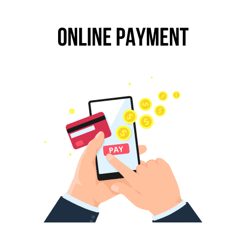
This accommodation of differing user preferences tends to reduce cart abandonment rates, as customers are less likely to stop a purchase due to the lack of their preferred payment option. It also can uplift the customer’s trust, as various options reflect professionalism and attention to customer needs.
Payment solutions pay close attention to security to earn and maintain trust. Security is a grave concern on both sides of a transaction, as phishing attempts, DDoS attacks, and all sorts of cyber threats endanger the safety of online transactions.
Encryption technology and SSL (Secure Socket Layer) certificates complement it, representing two key elements in establishing a secure connection and ensuring that all data is safe from unauthorized access. PCI DSS compliance, two-factor authentication (2FA), and fraud detection and prevention algorithms also maintain a secure environment.
All of these work toward a singular goal: secure processing and acceptance of payments from genuine customers. In most cases, they accomplish the mission of helping grow eCommerce transaction by transaction.
Mobile Commerce (M-Commerce)
Mobile commerce is a subsegment of eCommerce that refers to online transactions using mobile devices, such as smartphones and tablets. From the moment the first iPhone launched, the eCommerce landscape was poised to change — and it did. Online shopping has incrementally shifted to handheld devices, growing in popularity quickly.
Here is how much people rely on mobile devices for shopping: mobile commerce sales worldwide are projected to reach $2.52 trillion in 2024, which is 16.3% more than the $2.16 trillion in 2023.
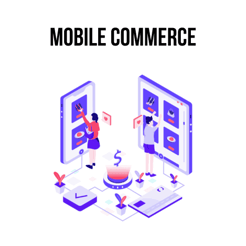
With the rise of smartphones and mobile shopping, it was all the more important to prioritize mobile usability. Incorporating responsive design and mobile-friendly interfaces into existing websites became unofficial standards when engaging target audiences, especially those who prefer shopping on their mobile devices or from regions lacking other digital infrastructure.
Let’s not forget that being mobile-oriented not only makes the user experience better but also directly affects engagement, conversion rates, and overall business success. It’s why some brands build their apps with purchasing capabilities and employ mobile-friendly payment solutions such as digital wallets.
The result is a smooth checkout experience that fully meets customer expectations and, ultimately, future-proofs an eCommerce business.
Artificial Intelligence (AI) and Machine Learning
It’s a well-known fact that eCommerce generates mountains of structured and unstructured data regarding customer behavior. And if there is one thing where AI has truly delivered on its promise, it’s elevating the customer experience by sifting through said data and adding a personal touch to the buyer journey.
Thanks to machine learning and predictive analytics, AI provides targeted interactions where every element is tailored to individual patterns and preferences. For example, recommendations suggest behaviorally and contextually relevant offers and items that personalize the shopping experience.

Offering such distinctive online experiences works wonders for eCommerce companies as they amplify customer satisfaction, nurture and engage customers, and develop brand loyalty.
Artificial intelligence excels in more than one area, though. For instance, it’s used for pricing optimization based on supply and demand evaluation. Businesses also proactively invest in AI-powered customer service and chatbots to deliver timely and efficient support.
This is particularly important for international clients, where forging long-lasting customer relationships depends in no small part on providing support in customers’ preferred languages, whether via a chatbot, virtual assistant, tutorial, or email.
Blockchain Technology
Although new to the scene, blockchain has found a place in online shopping by taking user security and protection to the next level. It provides transparent and tamper-resistant transactions by recording them on a distributed ledger, an immutable database where no one can modify or delete the transaction.

Users get peace of mind knowing that their sensitive data is securely stored, making it nearly impossible for malicious actors to manipulate or steal. Plus, since blockchain eliminates the need for intermediaries (primarily banks), it lessens the chance of vulnerability as the threat surface is reduced.
Besides increasing customer trust, blockchain technology can reduce costs throughout the supply chain. It provides the ability to track any digital or physical goods throughout their lifecycle, which means merchants can better understand the underlying stages. This can help identify and swiftly address issues that cost money, like inadequate compliance, delays, counterfeit goods, and waste.
Challenges and Opportunities in eCommerce
While staying afloat amid cut-throat competition is likely the main concern for online store owners, it’s equally paramount to safeguard oneself from the vast types of fraudulent activities and risks inherent to online business.
Security and Privacy Concerns
It’s a harsh truth that eCommerce stores are one of the biggest and easiest targets regarding security threats. There is no shortage of stories where data breaches, vulnerability exploits, and all kinds of malicious attacks have wreaked havoc on the bottom lines of both businesses and consumers.
Nothing damages or outright kills a brand’s reputation like a successful cyber attack in which confidential data has been accessed and manipulated. Simply put, customer loyalty works until there is a failure to adhere to security and privacy practices. Without either, consumers won’t visit or buy, nor can companies function without considering regulatory compliance and consumer protection.
One could also argue for more customer education by eCommerce platforms. They must intensify their efforts to raise awareness about safe practices and criminal activities, from creating strong passwords and properly securing devices to recognizing fraud attempts.
Competition and Market Saturation
Enticing people to check out your online store and convincing them to become customers is a hard sell when there are thousands of competitors. Everyone is trying to get noticed, making it all the more challenging to cut through the noise and stand out.
How well you acquire new customers greatly defines your success in this line of work. Some stores implement loyalty and referral programs, some organize giveaways and promotions, while others focus on SEO and site optimization tactics. There are plenty of strategies for differentiation and customer acquisition to try and find growth opportunities.
Among those, exploring niche markets and untapped demographics presents an attractive option. These offer several advantages often impossible to find in broader markets, such as reduced competition, easier positioning and marketing, stronger customer loyalty, and higher profit margins.
Naturally, there are challenges here, too, from limited market size and building awareness to scaling and growth. However, there is no denying that it can be a rewarding endeavor with careful planning and a customer-centric approach.
International Expansion and Localization
Boosting sales and revenue by expanding reach to international markets carries cultural and language barriers. If overlooked, these can bring far more harm than expansion would ever do good.
What seems normal in one place might be non-customary elsewhere, so it’s always a good idea to make sure images and translations match the local culture. The same goes for measurements, date formats, and other elements specific to local areas that might be confusing if not accounted for. From a technical perspective, the website layout needs to handle some languages that read differently.
Shipping internationally can get complicated and expensive if there is no clear overview of costs, delivery times, import rules, and so on. The potential for misunderstandings, delays, and, ultimately, unhappy customers is massive and not always easy to navigate around.
eCommerce Considerations
In the event all of the above sounds appealing to you, you’ll need some form of structure to deliver the best possible customer experience every time. You may have the absolute top product or service on the market, but your store is not guaranteed to flourish. To maximize your chances, take care of these things first:
1. Choosing the right eCommerce platform: You’ll have an abundance of options, each with specific advantages and disadvantages, so due diligence is, well, due on your part before picking one. Apart from budget, the platform of your choosing must have the functionality, integrations, and features you need.
In no particular order, some of the most popular include Adobe Commerce (great for running multiple stores or channels), BigCommerce (best for scaling an enterprise-level business), Shopify (all-in-one solution best suited for small businesses), Squarespace Commerce (very beginner-friendly), and WooCommerce (ideal for WordPress-based online stores).
2. Implementing effective marketing campaigns: A great deal of your store’s success hinges on its visibility, which is why SEO optimization is fundamental. For on-page SEO, you’ll have to improve website speed and insert keywords into your file names, title tags, meta tags, meta descriptions, and URLs. Off-page SEO is all about getting backlinks from reputable sites via guest posts, press mentions, and whatnot.
Email marketing is another valuable and affordable tool at your disposal. A strong email list can bring about numerous opportunities to connect with leads and customers via emails and newsletters that are highly personalized, visually appealing, and engaging enough to encourage a click and a conversion.
3. Enhancing customer experience: Sites that are easy to navigate, load fast, and ooze user-friendliness are the eCommerce standard. Otherwise, customers will turn away and land on a competitor’s website that offers a better experience.
The other side of the coin is optimizing for mobile. As of 2024, 60.67% of website traffic comes from mobile devices, so you’re risking a huge dropoff in traffic, engagement, and conversions if you don’t prioritize mobile optimization. This encompasses crafting a user experience that seamlessly adapts to multiple devices and channels. That’s what people expect!
4. Leveraging social media for eCommerce success: Consumers these days flock to social media networks for product discovery and recommendations besides the usual entertainment and connection. You can harness its power to raise brand visibility by showcasing your goods, educating potential customers about your business or trends, and building trust with engaging and emotional content.
You can also boost sales by using built-in features such as product tags, shop buttons, and swipe-up links. These make it easier than ever for customers to buy directly from their social feeds.
There is no formula for creating the optimal eCommerce strategy, but there is a way to start on the right foot. By understanding the landscape and making the most of the right platform, your venture can enjoy continual growth in the giant digital marketplace that is the internet.
Future Trends
It’s fair to say that eCommerce is one constantly shifting and expanding ecosystem. Hence, businesses have to put on their thinking caps and be creative and proactive about their digital strategies. In that regard, here are a few trends predicted to impact how consumers purchase online.
Augmented Reality (AR) and Virtual Reality (VR)
Thanks to the advances in the field of VR and AR, customers and retailers can take advantage of the ease and efficiency offered, providing shoppers with more immersive experiences and saving them the hassle when browsing, trying on/out, and paying for products.

Indeed, customers can spend less of their precious time window-shopping and enjoy the experience of trying out the product in virtual showrooms at their own pace and without ever leaving their homes (or any other place from where they shop) to visit a brick-and-mortar store.
This is achieved through virtual try-on (VTO) solutions, which allow clients to see how a product would fit them (or, say, a specific room in their house) using any device with a camera. While this technology has been around for some time, recent progress in facial recognition has added to its popularity.
That way, buyers can experience first-hand all the features and capabilities of virtual shopping through realistic interfaces. At the same time, retailers benefit from removed physical obstacles and clear and detailed descriptions of every product, which translates to improved sales figures.
Voice Commerce
The invention of voice technology and the introduction of Amazon Alexa, Google Assistant, Siri, Cortana, and others have allowed shoppers to search for products using nothing but their vocal cords — particularly popular among millennials.
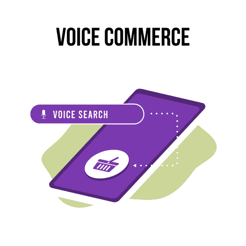
As it happens, 27% of search queries coming from mobile devices are carried out using voice. More than 40% of users from the millennial demographic rely on a voice assistant to complete searches, giving this tech a critical role in eCommerce.
Undoubtedly, combining voice search and AI in websites and apps can assist retailers in offering relevant product suggestions based on a better understanding of the search query, thus boosting satisfaction and building a loyal customer base.
On top of that, such a practice might particularly benefit smaller and local businesses, which might not be able to compete with major names when it comes to digital advertising. Instead, they could secure supplementary organic traffic from mobile devices and smart speaker-based shoppers.
Sustainability and Ethical Consumption
Green is the new black — at least when it comes to contemporary shoppers who are more attuned to their environment and preserving the planet than their predecessors have ever been. eCommerce brands have started to take notice, giving rise to sustainable businesses.

These brands proudly wear their eco-friendly badges, placing equal weight on profit and the environment. Hence, they receive more attention from the socially and environmentally conscious millennial and gen Z groups, the heavily predominant spenders in the economy.
Businesses are dealing with more than consumer preferences. Nowadays, their customers have grown accustomed to expecting, nay, demanding transparency and accountability, particularly in today’s era of freely available information and climate change awareness.
With such a demand becoming the norm, even the larger brand names are starting to move away from unsustainable habits, contributing to a 20% increase in sustainable products since 2014 and a four times higher compound average growth rate in sustainable products compared to their conventional counterparts.
Furthermore, environmental regulations have forced retailers to rethink previous practices, with nearly 1,000 such provisions aimed at the manufacturing sector in the United States. This number will only continue to increase, affecting the eCommerce industry as well.
The Endless Possibilities and Challenges of Global eCommerce
Running an online store is a cumbersome and often overwhelming gig. But it’s also a highly dynamic undertaking where buyer preferences are the catalyst for rapid disruption and growth, as well as obstacles that come with trying to please more than two different people.
So, every online store hoping to thrive must be flexible and scalable to adequately meet new demands and future-proof its operation. If there is an equation to solve for long-term success, this is likely it.







